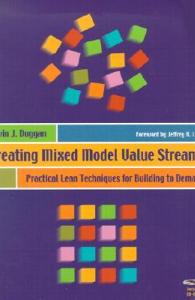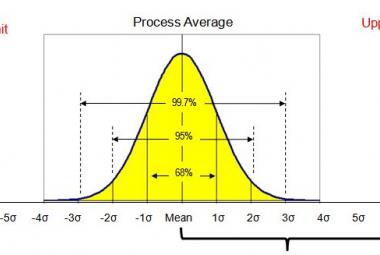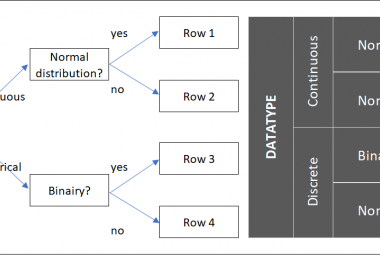Creating Mixed model Value Streams, by Kevin J. Duggan, is a sequel of Rother & Shook´s Learning to see (1999). Where Rother and Shook describe the basics of Value Stream Mapping, Duggan describes 10 challenges one might encounter when mapping a more complex value stream in which multiple product families are produced on the same resources (the so called mixed model Value Streams).
These topics include the definition of product families, defining the production interval, balancing operator work cycles and balancing the flow of the product mix. In this article, all 10 challenges described in the book are shortly addressed.
The first step in designing a Mixed Model Value stream is THE DEFINITION OF PRODUCT FAMILIES. Product flow is easier to implement when machines are used only for one product or product family, because this dedicated machine is 100% available to react to demand of his downstream customer. When machines are shared over multiple value streams, the machine can only supply one value stream at a time. The first goal in mixed model value streams therefore is to try to dedicate machines to a certain product family and the larger the product families are, the easier it becomes to dedicated machines to different families.
Duggan describes two guidelines for combining products into a family. Productions within the family should have 80% of process steps in common and the variance in total workload should not exceed 30% between products within the family.
Step number two describes the calculation of TAKT TIME for the entire family. Takt time is the interval in which the customer asks for products and can be calculated as follows:
Takt = (Total available production time) / (Total demand for all products in the family)
Note that the more products are put into a family, the lower the Takt time will be.
In the third step, one must CHECK WHETHER OR NOT THE MACHINES CAN KEEP TAKT for the family. Will all the machines in the production process be able to meet the Takt time calculated in step 2?
Two possible outcomes are that the analysis leads to a Kaizen to improve a machine to make sure it is able to meet Takt in the future, or to alter the product family if Takt cannot be kept.
The uptime of the machines is taken into account at this stage, which means the total necessary time to produce the entire family is corrected by the average downtime of the machine.
The difference between the time necessary to produce all products in a family and the Takt time can be used for change overs. To produce as closely to Takt as possible, the next step is to DEFINE THE INTERVAL in which all products in the family can be produced, which should be as short as possible. Shorter interval means maximizing the number of change overs to produce as closely to planned cycle time as possible and therefore following Takt time.
The shorter the interval, the better, because when products are produced more often, inventory buffers downstream of the workstation can be lower.
This is where the advantage of fast change-over times becomes clear. The faster one can switch between products, the short the interval of a product family can be, the smaller the buffers between workstations need to be, and the shorter the production Lead time of the product will be.
After the Machine part of production is compared to Takt time, step 5 describes the OPERATOR BALANCE CHARTS, to check if the operator cycles can also keep Takt.
The operator balance charts, also known as Yamazumi, visualizes the variations of workload per product, per operator.
Ideally, all operator cycle times are planned at 95% of Takt. Lower cycle times encourage overproduction and higher cycle times increase the possibility that Takt cannot be kept and customers will not be served as planned.
Step 6 describes BALANCING THE MIX of the production line. The fact that the total workload of the family can keep Takt, doesn’t necessarily mean every individual product can keep Takt.
It is therefore necessary to define a fixed sequence (also see the article about: Heijunka) in which the differences in cycle times for different products are planned in the sequence they can compensate each other. If change over times are equal for all changes, start with a shorter cycle time first, to buffer capacity for the products with a longer cycle time later in the sequence. When change overs vary within a family, that might be the leading indicator to plan the fixed sequence.
Two other options are to keep a finished goods supermarket for products with the highest work content, or to use flexible working hours to react to changes in customer demand.
CREATE STANDARD WORK for all employees, to make sure everyone can deliver products at the planned cycle time.
When creating standard work documents, make sure you use as many pictures and symbols as possible, to reduce the amount of text.
Ideally, standards are defined with the help of the people who work with them, and the engineers who developed the machines which are used for production.
When all work is planned and it is clear how the job is to be done, the next step is to check whether or not the plan is kept. This is what step 8, THE CREATING OF THE PITCH is all about.
The pitch is an interval which varies between 15 minutes und 2 hours, in which a person checks whether or not we are still on schedule. This person, called the Pitch runner, visits every workstation to collect the work of the last interval and bring raw materials for the next interval.
The system works like a train system and is often even implemented with an actual train. The train has a fixed schedule to bring and pick up products at (train) stations. Whenever the product is not at the station when the train comes to pick it up, there is a problem which needs to be addressed.
The Pitch runner uses the PRODUCTION PLAN on the pacemaker (the one workstation that automatically triggers the rest of process in an ideal process) to check whether or not production is still producing according to plan. This can be done using the Heijunkabox in which the work units to be produced are planned according to the pitch interval.
Finally, Duggan describes the problem of DEALING WITH CHANGING CUSTOMER DEMAND. There are many situations in which customer demand changes due to product lifecycles or even seasonal changes.
One can buffer for these variations using dynamic supermarkets, which means that each supermarket has more than one fixed size for different (planned) situations.
In creating Mixed Model Value Streams, Duggan helps to prevent managers solving Value Stream Design problems in situations where production is relatively complex.
A final important note is that for each of the 10 themes described in both the book and this article, there is no right or wrong in any of the challenges. One of the main principles in the lean philosophy is continuous improvement, which means that product families, balance charts, machine layout, product sequences and pitch routes all can be improved whenever needed.
Simply use the Value Stream Map as the guideline for all improvements and define Kaizenevents whenever a change is needed.
Continue to:
Learning to See – M.Rother & J.Shook (summary)
SOURCES:
Duggan, K.J, 2002, Creating Mixed Model Value Streams - Practical Lean Techniques for Building to Demand, USA: CRC press. (order this book)
Rother, M., Shook, J., 1999, Learning To See - Value Stream Mapping to Create Value and Eliminate Muda, Brookline, Massachusetts: Lean Enterprise Institute (summary / order this book)












